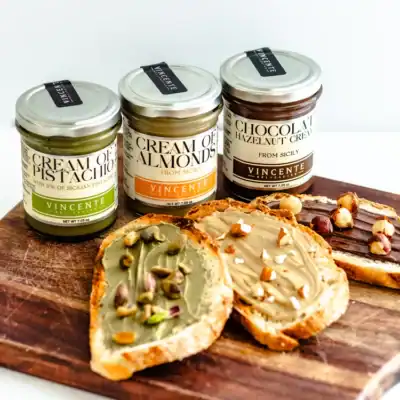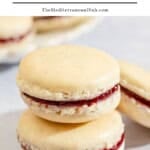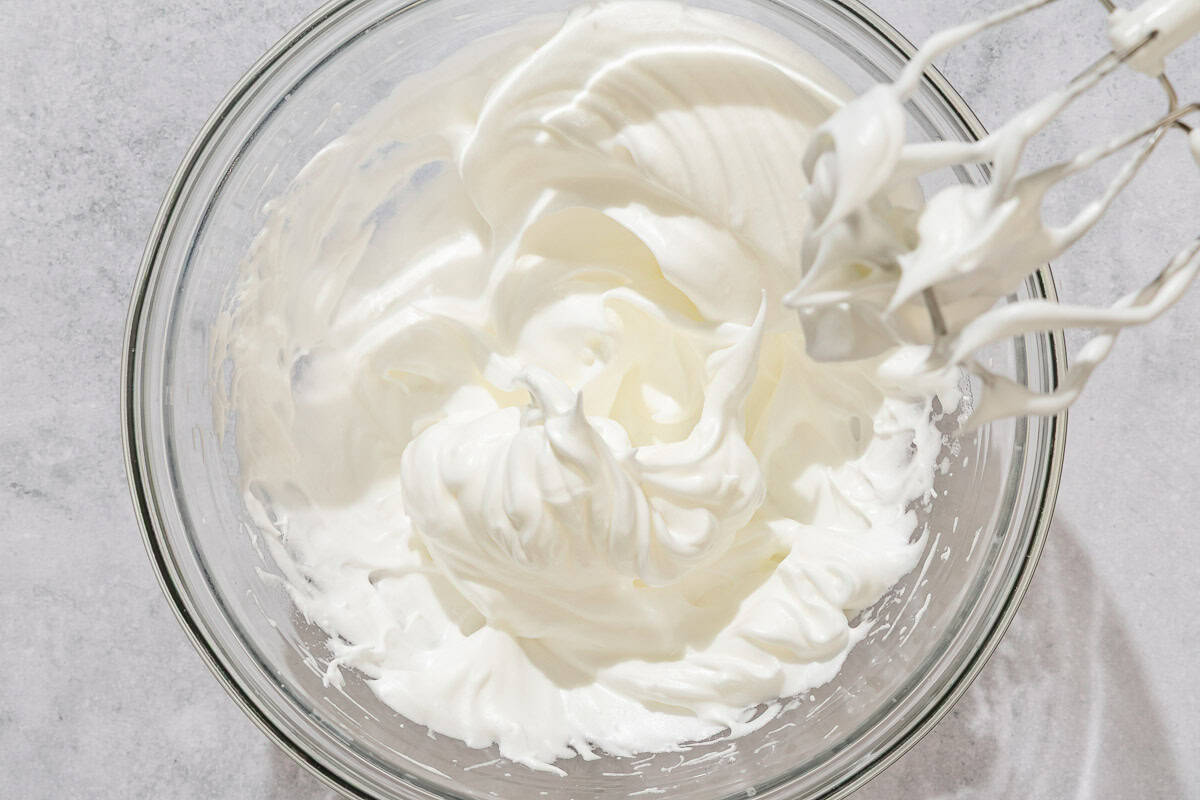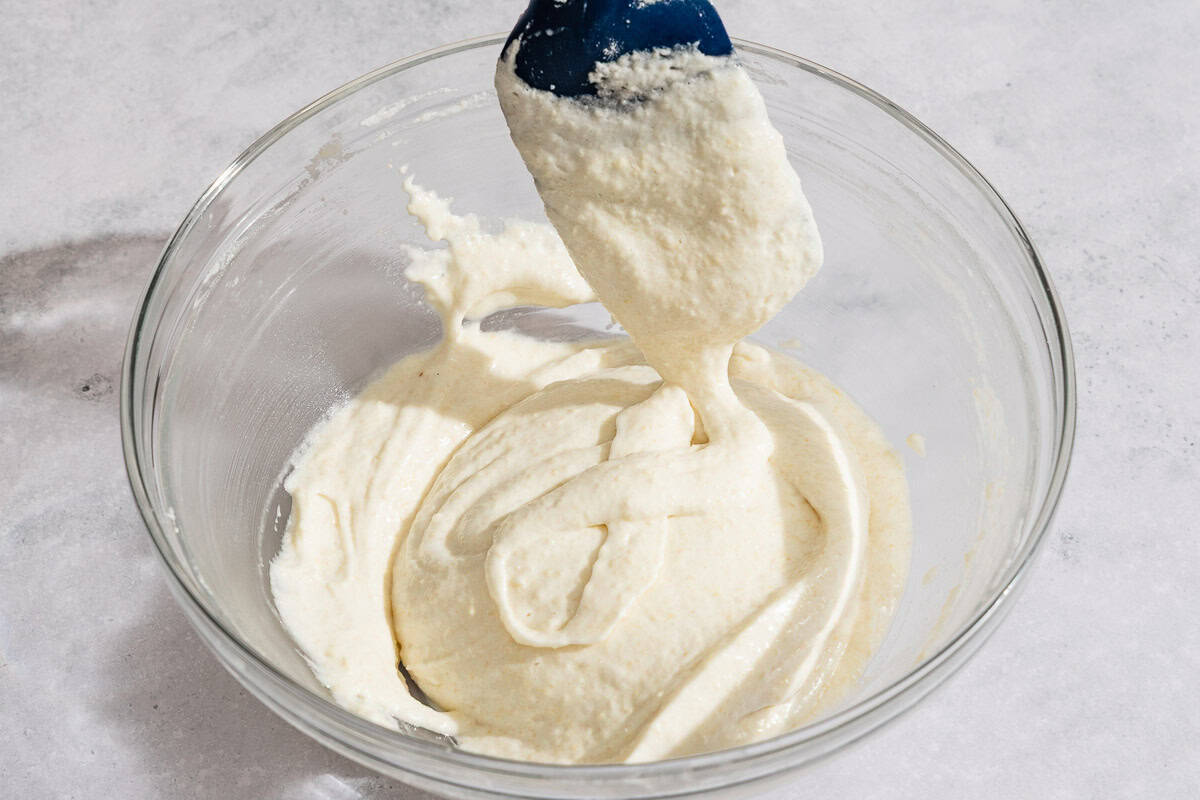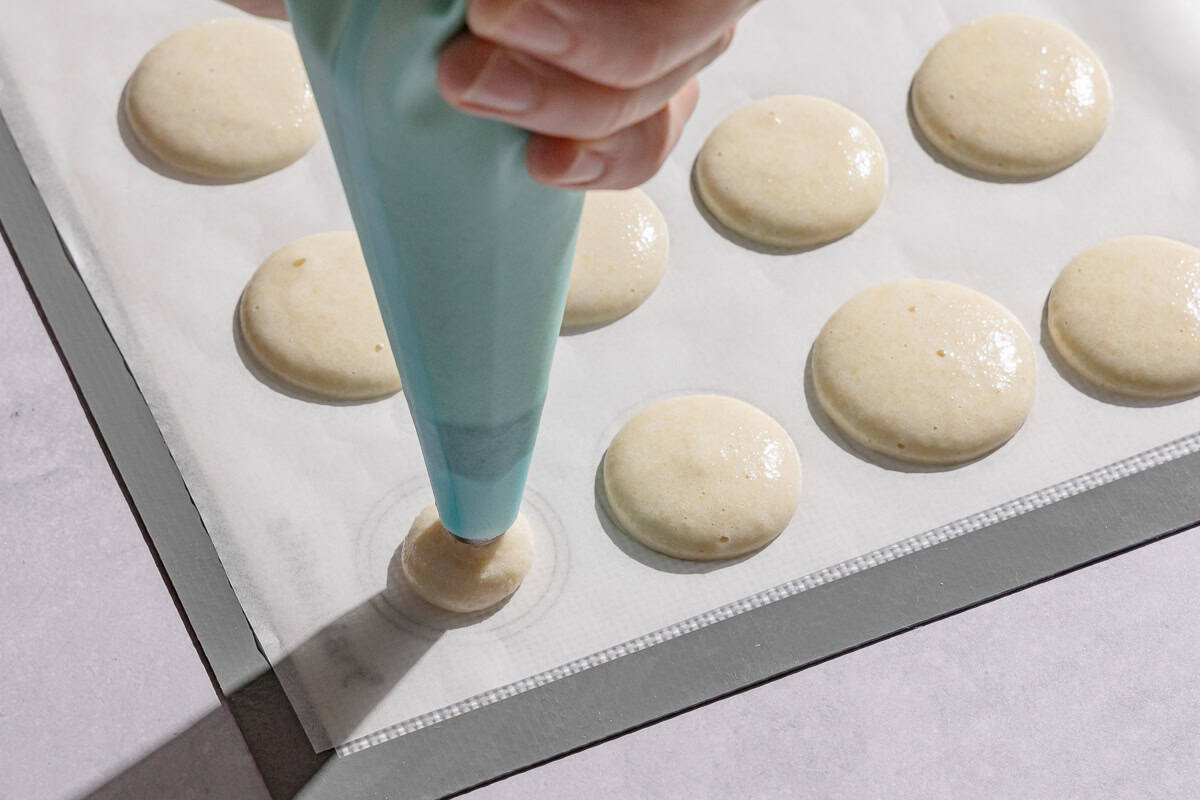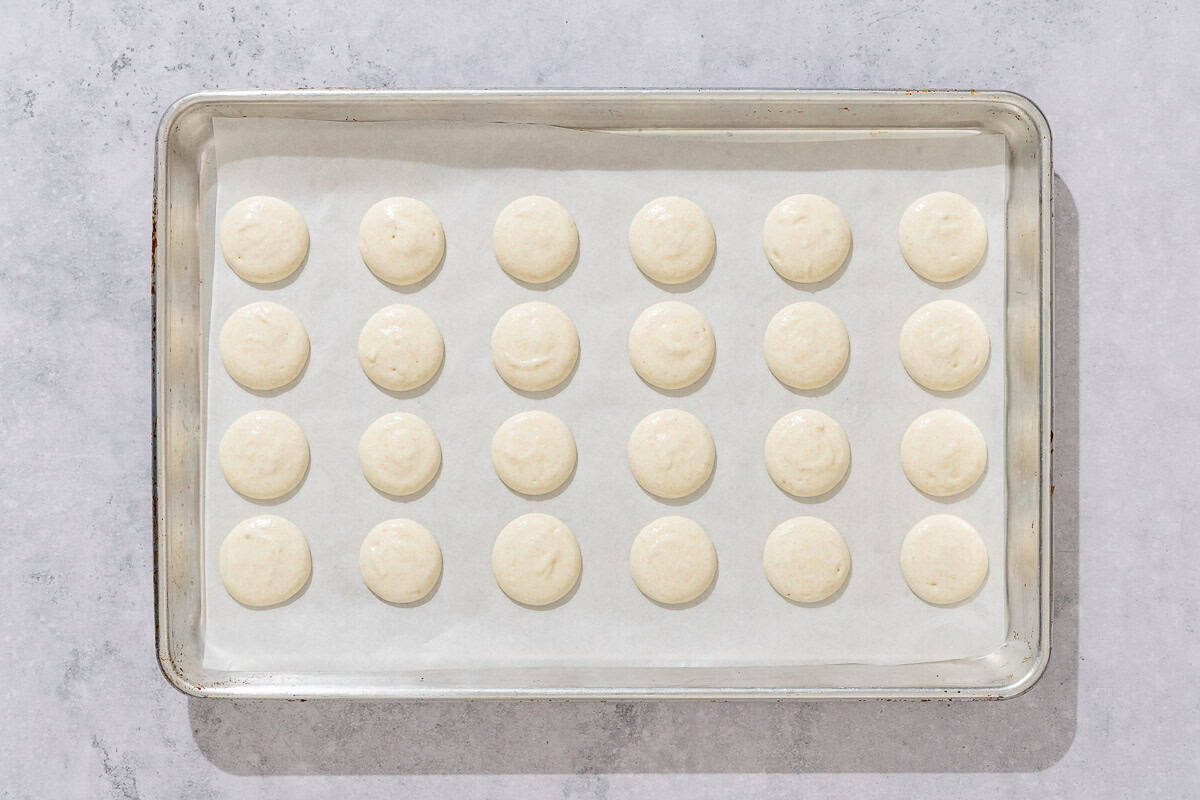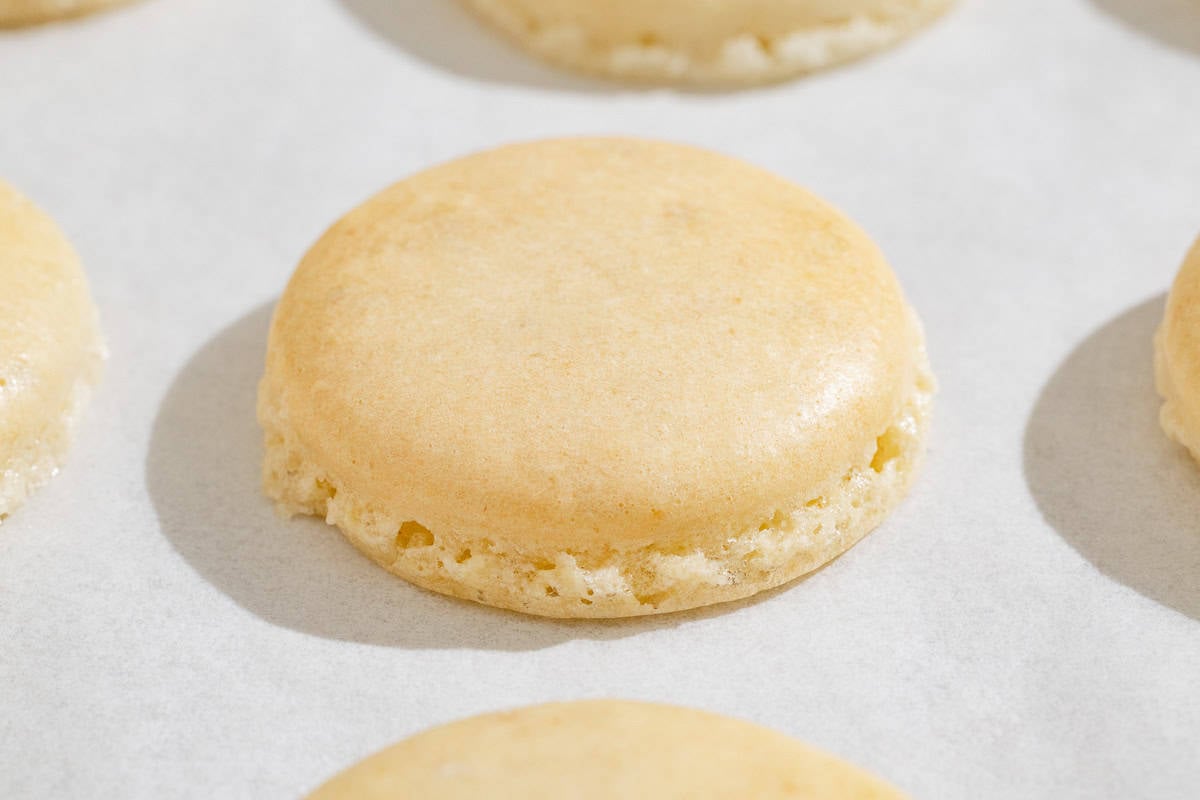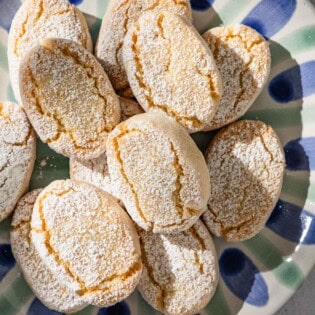Make French macarons, elegant gluten-free sandwich cookies with a crisp shell and a tender interior, at home with this easy step-by-step guide from a professional baker.

Macarons are delicate and naturally gluten-free French almond meringue cookies filled with jam, ganache, or buttercream.
Though they have a reputation for being finicky, they’re absolutely achievable at home if you’re comfortable making meringue and using a piping bag. The trickiest part is learning to recognize when the batter reaches the perfect consistency before piping. This takes practice, possibly over a few batches, but I have plenty of advice—I made thousands of them as a professional baker—and I promise that even imperfect macarons taste heavenly.
Macarons come in bright colors and myriad flavor combinations, from classic almond to more creative combinations like avocado and grapefruit. I prefer classic flavor pairings, so this recipe is for almond macarons with a jam filling, but I’ve got plenty of advice for how to customize the shells and filling variations below.
Macarons Ingredients
Macarons rely on technique rather than a long ingredient list. Because they use almond flour, they’re naturally gluten-free. Here’s everything you’ll need:
- Almond flour: Use almond flour and not almond meal, which includes the skin and can be coarser. If you can find it, opt for superfine almond flour, which creates a smooth appearance and texture.
- Powdered sugar sweetens the cookie shells and adds bulk to the batter.
- Salt balances the sweetness and enhances the almond flavor.
- Egg whites whip into a meringue that provides the macarons’ structure. In my experience, fresh egg whites instead of liquid egg whites from a carton work best and most consistently.
- Granulated sugar stabilizes the meringue, giving it extra volume, and sweetens the macarons.
- Almond extract is made from bitter almonds and other stone fruit pits. It has a strong, slightly fruity flavor. Just a little goes a long way. You can substitute one teaspoon of vanilla extract if you prefer.
- Jam: Store-bought jam is an easy, fruity filling for macarons. My favorite is raspberry because its tart flavor balances the sweetness of the macaron shells, but you can use your favorite jam. Choose a thick jam that isn’t runny.
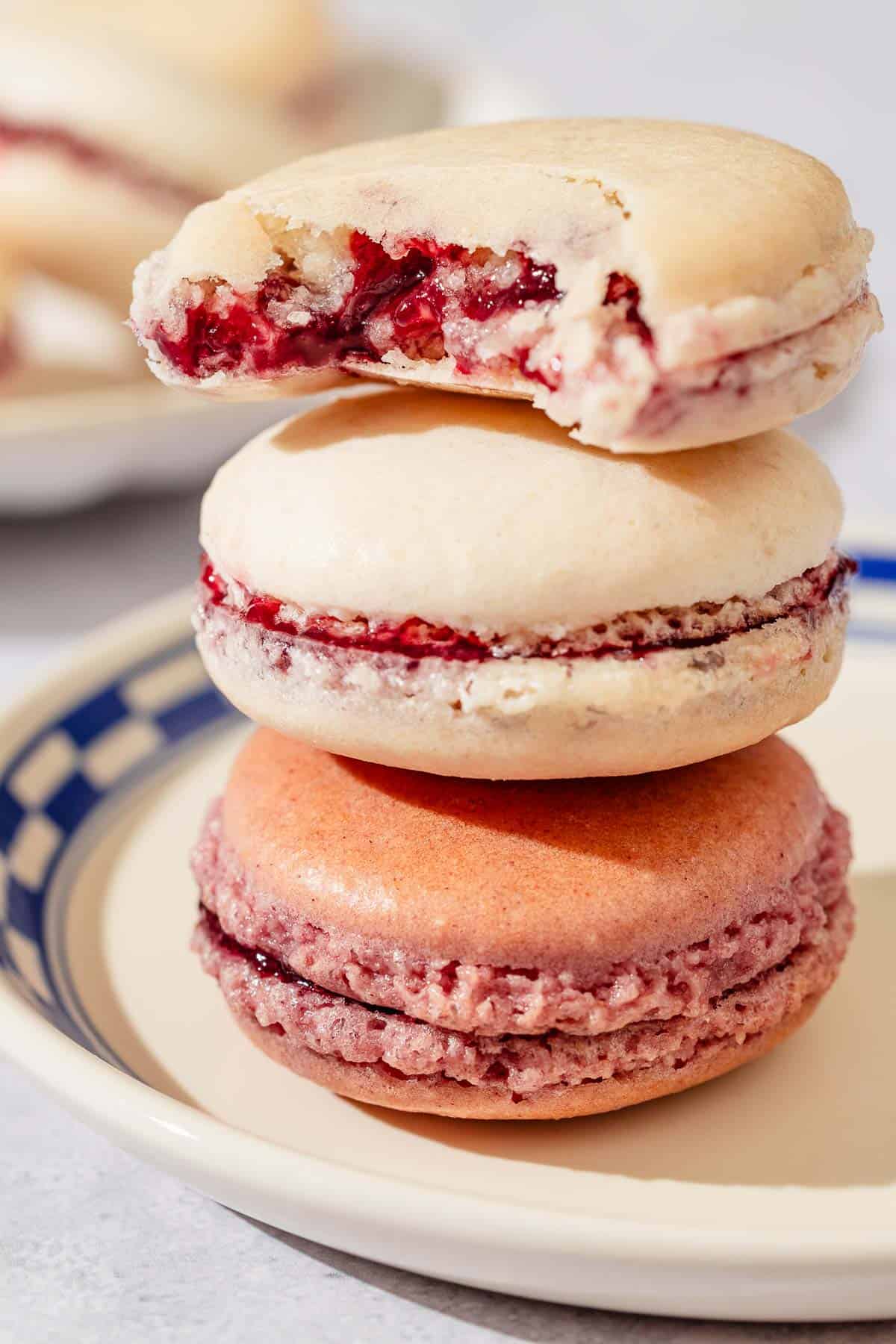
How to Make Macarons
Mixing the batter only takes about 15 to 20 minutes, but the piped macarons will need to rest for at least 45 minutes before baking. Macarons have the best texture if they age in the refrigerator for 24 hours, so bake macarons the day before you plan to serve them.
- Get ready. Cut a piece of parchment paper to fit neatly in a baking sheet. Use a permanent marker to trace 1 1/4-inch circles (tracing a quarter works well for this) spaced 1 inch apart. Place the parchment paper, marker-side down, in the baking sheet.
- Grind and sift the dry ingredients. In the bowl of a food processor, combine 3/4 cup (75g) almond flour, 1 cup (113g) powdered sugar, and 1/4 teaspoon kosher salt. Pulse until extra fine, 10 to 15 (1-second) pulses. Sift through a mesh sieve into a mixing bowl, and discard any large pieces that remain in the sieve.
- Make the meringue. Beat 2 large egg whites (65g) in a large mixing bowl with a hand mixer or the bowl of a stand mixer with the whisk attachment on medium speed until frothy, about 30 seconds. Increase the speed to medium-high, and add 1/4 cup (50g) granulated sugar in a slow, steady stream. Pour in 1/2 teaspoon almond extract, and continue to whip on medium-high speed until the meringue has a satin sheen and stiff peaks form, 3 to 4 minutes.
- Make the batter (Macaronage). Add about half of the dry ingredients to the meringue. Use a large silicone spatula to gently fold the mixture until incorporated. Add the remaining dry ingredients and gently fold to combine. Continue gently mixing, scraping the bottom and sides of the bowl, to loosen the batter, until it has lost about half its volume, is shiny, and flows off the spatula in a smooth ribbon. You should be able to make a figure eight in the batter without it breaking, and the figure eight should slowly melt back into the batter.
- Prepare to pipe the macarons. Glue the parchment paper to the baking sheet using a small dab of batter in each corner. Scrape the batter into a piping bag fitted with a 1/2-inch (1cm) round piping tip. Twist the bag to close.
- Pipe the macarons. Holding the bag perpendicular (straight up and down) with the tip about 1/2-inch above the center of one of the traced circles, apply steady pressure to the bag until the macaron batter fills the circle. Stop squeezing the bag, lift, and quickly twirl the tip to break the flow of the batter cleanly. Continue filling in the rest of the circles. Tap the baking sheet firmly on a towel-lined work surface a few times to pop any large air bubbles. Use a toothpick to pop any large bubbles below the surface and fill in the depressions left by the popped bubbles.
- Dry the macarons. Let the macarons stand uncovered at room temperature for about 45 minutes, or until the surfaces are matte and have formed a thin skin. This may take longer if you live in a humid area. You should be able to gently poke them without the batter sticking to your finger.
- Get ready to bake. While the macarons dry, preheat the oven to 300°F (150°C).
- Bake. Bake the macarons in the preheated oven for 12 to 16 minutes. The macarons should be dry on the surface, with a ruffled foot around the base. If you gently wiggle a macaron, it should stay put on the parchment and not jiggle. If you used more than one baking sheet, bake them one at a time.
- Cool. Let the macarons cool completely on the baking sheet, then carefully peel them from the parchment paper.
- Fill. Transfer the jam to a piping bag fitted with a round piping tip. Pipe a generous teaspoon of jam on the flat side of half of the cooled shells, then sandwich them with the remaining shells.
- Age and serve. Carefully pack the macarons into a container, cover, and refrigerate for at least 24 hours. Serve chilled. The macarons will keep for up to 5 days in an airtight container in the fridge.
What is a Macaron?
Macarons are almond flour and meringue-based sandwich cookies usually filled with ganache, buttercream, or jam. Macaron shells have a thin, crisp outer layer that yields to a soft and chewy center.
While they now come in dozens of elegant flavors and colors, it wasn’t until the 1930’s that a Parisian pastry chef, Claude Gerbet, created the refined sandwich cookie we know today. The alluring texture of their crisp shell surrounding a soft, chewy interior has made them a world-famous cookie for centuries.
They are different from coconut macaroons, which are a sweet drop cookie.
Equipment List
If you’re looking to achieve the best macarons, there are some essential pieces of equipment that you’ll need at the ready. Except for the food processor, all of these tools are crucial for baking successful macarons.
- Kitchen scale: Macarons rely on specific ratios to work, and volume measurements are not as consistent as weight measurements. I always bake using a kitchen scale, but it’s especially crucial when making macarons.
- Food processor: If you have superfine almond flour, a food processor isn’t strictly necessary. But for smooth macarons, I always process the dry ingredients just in case.
- Fine mesh sieve: A sieve will catch and remove any larger pieces out of the almond flour and prevent lumps from forming in the batter.
- Electric mixer: An electric hand mixer or a stand mixer is helpful for beating the egg whites to stiff peaks.
- Piping bag and tip: For properly portioned and shaped macarons, you need a piping bag and tip. I like to use a reusable piping bag and a 1/2-inch (1cm) round piping tip, such as Wilton 2A or Ateco 804.
- Baking sheet: Do not use a dark baking sheet. It absorbs and spreads heat more efficiently than a lighter colored pan, which can cause your macarons to crack in the oven. You can use either a rimmed or unrimmed baking sheet. However, an unrimmed baking sheet can be handy for sliding the parchment paper on and off the sheet without distorting the macarons.
- Parchment paper: While some people swear by silicone baking mats, I highly recommend using parchment paper. Silicone doesn’t conduct heat as well, and macarons baked on a silicone mat need to bake longer. With silicone, I’ve had problems with the foot not forming or the tops browning before they’re fully baked. If you already have silicone mats with circles printed on them, they make great stencils for tracing on parchment paper.

What is Macaronage?
After mixing in the dry ingredients, the batter still needs to be worked until it reaches the perfect consistency for macarons. This process of working the batter to the proper consistency is called macaronage.
This is one of the most challenging steps of making macarons, and gaining a feel for the right consistency takes practice. If the batter is underworked, the macarons will be lumpy and have a hollow interior. Overmixed batter can produce macarons without feet or that crack in the oven.
Use a wide silicone spatula to gently fold the batter. Keep folding until the batter has lost about half its volume. The batter should be smooth and glossy, and flow off the spatula in a smooth ribbon. You should be able to make a figure eight in the batter without it breaking, and the figure eight should slowly melt back into the batter in about 10 seconds.
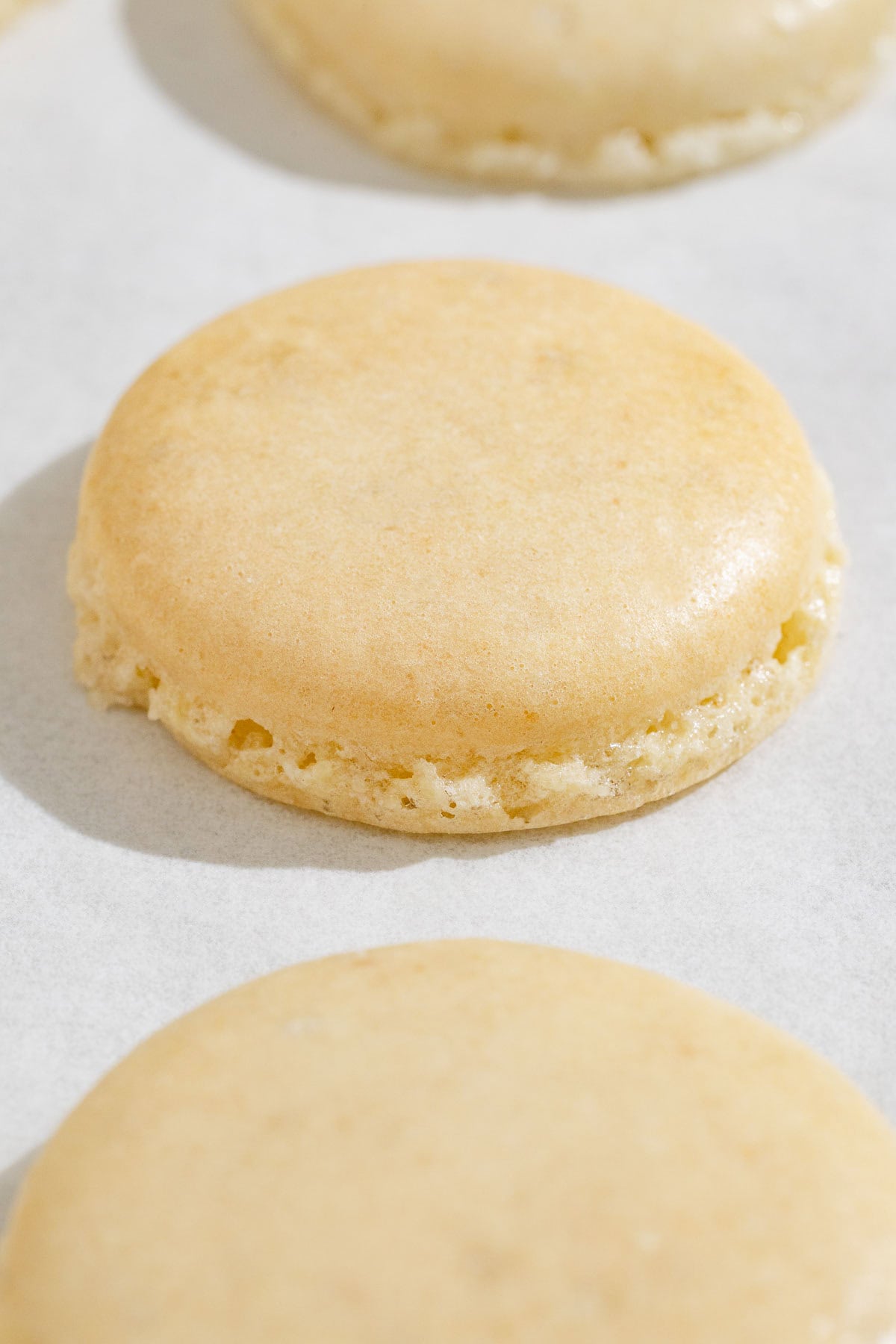
What is a Foot?
A macaron shell has a smooth top called a crown and a frilly base called the foot. They’re the tell-tale sign of a correctly mixed and rested macaron. During baking, the air trapped in the batter expands and needs to escape. During resting, a skin forms on the top, creating the crown. The air cannot escape through the crown and exits out the sides, making the characteristic, ruffled foot.
How to Flavor Macaron Shells
Flavoring macaron shells can be controversial, depending on who you ask. There’s a huge opportunity for fun flavor combinations, so I’m in favor. Unfortunately, extra ingredients can cause some baking issues, so it may take some testing for them to come out just how you want. But even if they’re not perfect, at least they’ll taste good.
- Berry macarons: Freeze-dried raspberry, strawberry, or blueberry powder will add a fruity flavor and a bit of color to your macarons. Add 1 tablespoon of freeze-dried berry powder to the dry ingredients. Adding freeze-dried berry powder will cause macarons to brown faster in the oven. Lower the temperature to 275°F and bake for 16 to 20 minutes.
- Chocolate macarons: Cocoa powder gives the shells a rich, chocolate flavor. Reduce the powdered sugar to 3/4 cup plus 2 tablespoons (100g) and add 2 tablespoons (12g) unsweetened cocoa powder to the dry ingredients. Different brands of cocoa vary significantly in fat content. A cocoa powder high in fat can cause macarons to have a wrinkly appearance.
- Espresso macarons: Add 1 teaspoon instant espresso powder to the dry ingredients.
- Cinnamon macarons: Add 1 1/2 teaspoons ground cinnamon to the dry ingredients.
- Cardamom macarons: Add 1/2 teaspoon ground cardamom to the dry ingredients.
- Rose water macarons: Add 1/2 teaspoon rose water in place of the almond extract. For a stronger rose flavor, make a white chocolate ganache using the instructions below and add 1 teaspoon rose water to the ganache.
- Orange blossom macarons: Add 3/4 teaspoon orange blossom water in place of the almond extract. For a stronger orange blossom flavor, make a white chocolate ganache using the instructions below and add 1 teaspoon orange blossom water to the ganache.
Tips for Coloring Macaron Shells
Depending on the flavor you choose and how festive you’d like the macarons to appear, a bit of color can add an appetizing pop.
- Use gel food coloring, which is more concentrated than liquid food coloring. Macaron batter doesn’t take on extra liquid well.
- Add the food coloring while making the meringue, instead of at the end of mixing, because the final consistency of the batter is vital to the success of your macarons.
- After adding all of the granulated sugar to the whipped egg whites, continue beating the meringue until soft peaks form.
- Add the food coloring one drop at a time, beating on low speed, until you achieve the desired hue.
- Continue beating the meringue on medium-high speed until stiff peaks form. Remember: The color will darken slightly in the oven.

Filling Ideas
Fillings add infinite flavor possibilities to your macarons. While buttercream is the most common filling, my favorites are jam or chocolate ganache. Fillings thick enough to pipe and hold their shape work best. Here are a few filling ideas to get you started:
- Jam: Use your favorite jam as an easy filling for homemade macarons. You want to use thick jam that holds its shape. If the jam you have is too runny, add the jam to a small saucepan and simmer for about 10 minutes, stirring occasionally. Let it cool completely before filling the macarons. The jam will thicken as it cools.
- Chocolate ganache: Another classic macaron filling is rich, chocolate ganache, which works well to tone down the sweetness of the macaron shells.
- To make chocolate ganache: finely chop 4 ounces (113g) semi-sweet chocolate and place in a heatproof bowl. Heat 1/2 cup (120ml) heavy cream in a small saucepan over medium heat just until it begins to simmer. Pour the hot cream over the chocolate and let it sit for 2 to 3 minutes without stirring. Then stir with a spatula until the chocolate has melted and the ganache is smooth and shiny. Let it cool completely before piping onto the macarons.
- Espresso chocolate ganache: Use the above instructions for chocolate ganache, adding 1/2 teaspoon espresso powder to the heavy cream.
- Lemon curd: Lemon curd makes a bright and zingy filling for macarons. You could also try another citrus curd, such as orange, grapefruit, or lime.
- Nut creams: Not to be confused with nut butters like peanut butter or almond butter, nut creams are very smooth, fine spreads that contain both finely ground nuts, as well as sugar and sometimes milk powder. The result is a super creamy and delicately sweetened spread with the lush texture of a pastry cream. Use almond, pistachio, or chocolate-hazelnut creams as easy, ready-made macaron fillings.

Troubleshooting Macarons
Learning to bake macarons is a never-ending process. After baking countless batches, I don’t think the perfect macaron exists. With every batch, I learn something new. Here are some of the most common issues bakers face in their macaron journey and their causes. Enjoy the process, and remember that even if they’re not pretty, they’re usually pretty delicious.
- Hollow macarons: It’s an unpleasant surprise when you bite into a macaron and the shell cracks to reveal nothing but air. There are several possible reasons for hollow macaron shells. Both over- and undermixing can cause hollow shells. Make sure to pop the air bubbles in the piped macarons, as these bubbles will expand in the oven. The oven could be too hot, or the macarons could be underbaked.
- Cracked macarons: Cracked macarons are usually a sign that the oven was too hot or that the macarons were overbaked. Every time I tested a dark baking sheet, my macarons cracked.
- No feet: If your macarons have no feet, the oven may have been too cool, or the macarons may have rested too long. If they had a foot in the oven, but not after cooling, the macarons weren’t baked long enough to set, and they deflated.
Mediterranean Cookie Recipes You’ll Love
Browse all Mediterranean recipes.
Visit Our Shop.
Macarons
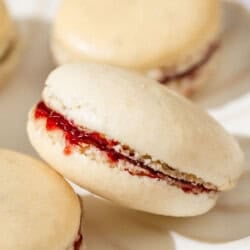
Ingredients
- 3/4 cup almond flour (75g)
- 1 cup powdered sugar (113g)
- 1/4 teaspoon kosher salt
- 2 large egg whites (65g)
- 1/4 cup granulated sugar (50g)
- 1/4 teaspoon almond extract
- 1/2 cup jam (see below for other filling suggestions)
Instructions
- Get ready. Cut a piece of parchment paper to fit neatly in a baking sheet. Use a permanent marker to trace 1 1/4-inch circles spaced 1 inch apart. Place the parchment paper, marker-side down, on the baking sheet.
- Grind and sift the dry ingredients. In the bowl of a food processor, combine the almond flour, powdered sugar, and salt. Pulse until extra fine, 10 to 15 (1-second) pulses. Sift through a mesh sieve into a mixing bowl, and discard any large pieces that remain in the sieve.
- Make the meringue. Beat the egg whites in a large mixing bowl with a hand mixer or the bowl of a stand mixer with the whisk attachment on medium speed until frothy, about 30 seconds. Increase the speed to medium-high, and add the granulated sugar in a slow, steady stream. Pour in the almond extract, and continue to whip on medium-high speed until the meringue has a satin sheen and stiff peaks form, 3 to 4 minutes.
- Make the batter(Macaronage). Add about half of the dry ingredients to the meringue. Use a large silicone spatula to gently fold the mixture until incorporated. Add the remaining dry ingredients and gently fold to combine. Continue gently mixing, scraping the bottom and sides of the bowl, to loosen the batter, until it has lost about half its volume, is shiny, and flows off the spatula in a smooth ribbon. You should be able to make a figure eight in the batter without it breaking, and the figure eight should slowly melt back into the batter.
- Prepare to pipe the macaron shells. Glue the parchment paper to the baking sheet using a small dab of batter in each corner. Scrape the batter into a piping bag fitted with a 1/2-inch (1cm) round piping tip. Twist the bag to close.
- Pipe the shells: Holding the bag perpendicular (straight up and down) with the tip about 1/2-inch above the center of one of the traced circles, apply steady pressure to the bag until the macaron batter fills the circle. Stop squeezing the bag, lift, and quickly twirl the tip to break the flow of the batter cleanly. Continue filling in the rest of the circles. Tap the baking sheet firmly on a towel-lined work surface a few times to pop any large air bubbles. Use a toothpick to pop any large bubbles below the surface and fill in the depressions left by the popped bubbles.
- Dry the macaron shells. Let the macarons stand uncovered at room temperature for about 45 minutes, or until the surfaces are matte and have formed a thin skin. This may take longer if you live in a humid area. You should be able to gently poke them without the batter sticking to your finger.
- Get ready to bake. While the macarons dry, preheat the oven to 300°F (150°C).
- Bake the macaron shells. Bake the macarons in the preheated oven for 12 to 16 minutes. The macarons should be dry on the surface, with a ruffled foot around the base. If you gently wiggle a macaron, it should stay put on the parchment and not jiggle. If you used more than one baking sheet, bake them one at a time.
- Cool the shells. Let the macarons cool completely on the baking sheet, then carefully peel them from the parchment paper.
- Fill the macarons. Transfer the jam to a piping bag fitted with a round piping tip. Pipe a generous teaspoon of jam on the flat side of half of the cooled shells, then sandwich them with the remaining shells.
- Age and serve. Carefully pack the macarons into a container, cover, and refrigerate for at least 24 hours. Serve chilled. The macarons will keep for up to 5 days in an airtight container in the fridge.
Notes
- Visit our shop to browse quality Mediterranean ingredients, including olive oils, honey, jams, and spices.
- To Color the Macaron Shells: Macarons don’t take on extra liquid well, so use a gel food coloring, which is more concentrated anyway. Because the final consistency of the batter is so vital to the success of your macarons, add the food coloring while making the meringue, instead of at the end of mixing. After adding all of the granulated sugar to the whipped egg whites, continue to beat the meringue until soft peaks form. Add the food coloring one drop at a time, beating on low speed, until you achieve the desired hue. Then, continue beating the meringue on medium-high speed until stiff peaks form. Remember the color will darken slightly in the oven.
- Berry macarons: Freeze-dried raspberry, strawberry, or blueberry powder will add a fruity flavor and a bit of color to your macarons. Add 1 tablespoon of freeze-dried berry powder to the dry ingredients. Adding freeze-dried berry powder will cause macarons to brown faster in the oven. Lower the temperature to 275°F and bake for 16 to 20 minutes.
- Chocolate macarons: Cocoa powder gives the shells a rich, chocolate flavor. Reduce the powdered sugar to 3/4 cup plus 2 tablespoons (100g) and add 2 tablespoons (12g) unsweetened cocoa powder to the dry ingredients. Different brands of cocoa vary significantly in fat content. A cocoa powder high in fat can cause macarons to have a wrinkly appearance.
- Espresso macarons: For coffee-flavored macarons, add 1 teaspoon instant espresso powder to the dry ingredients.
- Cinnamon macarons: For cinnamon-flavored macaron shells, add 1 1/2 teaspoons ground cinnamon to the dry ingredients.
- Cardamom macarons: For cardamom-flavored macaron shells, add 1/2 teaspoon ground cardamom to the dry ingredients.
- Rose water macarons: For rose flavored macarons, add 1/2 teaspoon rose water in place of the almond extract. For a stronger rose flavor, make a white chocolate ganache using the ganache instructions below and add 1 teaspoon rose water.
- Orange blossom macarons: For orange blossom-flavored macarons, add 3/4 teaspoon orange blossom water in place of the almond extract. For a stronger orange blossom flavor, make a white chocolate ganache using the ganache instructions below and add 1 teaspoon orange blossom water.
- Jam: Use your favorite jam as an easy filling for homemade macarons. Use a thicker jam that holds its shape when piped onto the macarons. If the jam is too runny, you can thicken it on the stove. Add the jam to a small saucepan and simmer for about 10 minutes, stirring occasionally. Let it cool completely before filling the macarons. The jam will thicken as it cools.
- Chocolate ganache: Another classic macaron filling is rich, chocolate ganache, which works well to tone down the sweetness of the macaron shells. To make chocolate ganache, finely chop 4 ounces (113g) semi-sweet chocolate and place in a heatproof bowl. Heat 1/2 cup (120ml) heavy cream in a small saucepan over medium heat just until it begins to simmer. Pour the hot cream over the chocolate and let sit for 2 to 3 minutes without stirring. Then stir with a spatula until the chocolate has melted and the ganache is smooth and shiny. Let it cool completely before piping onto the macarons.
- Espresso chocolate ganache: Use the above instructions for chocolate ganache, adding 1/2 teaspoon espresso powder to the heavy cream.
- Lemon curd: Lemon curd makes a bright and zingy filling for macarons. You could also try another citrus curd, such as orange, grapefruit, or lime.
- Nut creams: Not to be confused with nut butters like peanut butter or almond butter, nut creams are very smooth, fine spreads that contain both finely ground nuts, as well as sugar and sometimes milk powder. The result is a super creamy and delicately sweetened spread with the lush texture of a pastry cream. Use almond, pistachio, or chocolate-hazelnut creams as easy, readymade macaron fillings.
Nutrition
Three Sweet Spreads from Sicily
Indulge with this artisanal trio of premium nut creams, handcrafted in small batches using locally grown ingredients and free from artificial additives.
